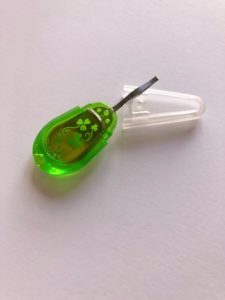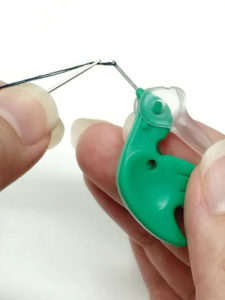
Over the weekend I tried two unusual needle threaders for my stitching. Both the Clover Embroidery Threader (top) and the Dritz hummingbird Needle Threader (bottom) have some great features that make them worth your consideration for needlepoint.
They were used on the same project, Bargello on 18 mesh canvas using crewel wool. I had been using other threaders up to that point in the project, so this was a great test.
Common Characteristics
Both threaders are small and considerably thicker than metal threaders. They are small enough to fit into any project bag but thick enough to be easy to find. Unlike thinner threaders, I never had a problem picking these up. With other threaders I put them on loops of thread so I can grab them more easily. I didn’t need to do that here.
Both have clear plastic covers for the business end. it’s great because it protects the wire threader. But there is a downside, especially if you keep your metal threader attached to a magnet. Being mostly plastic, these can’t really be stored that way. There are holes, however, to store on your chatelaine or to put the thread through to hang on your frame.
Dritz Threader
As you can see from the picture above, the Dritz threader is in the shape of a small bird. It’s called a hummingbird threader because the threader, a single wire, is the beak. An attached cover lifts up and down to protect the wire, which could easily bend if left uncovered.
The method to use this threader is quite unusual. It’s so strange that there are instructions on the back of the package. Lift up the cover and put your needle onto the wire and push it down to the base. Loop the thread over the tip of the wire and pull the needle up and over the thread to beyond the tip. Push the needle down the thread until one end of the thread is clear of the eye.
Your needle is threaded and you can remove the threader.
The process of moving the needle to thread is the opposite of the way loop threaders work. There you move the thread not the needle. It is the way hook threaders work, but here there is no hook.
The first time I tried using it I moved the thread and pulled it right out of the needle!
Clover Threader
The Clover threader looks more like a conventional sewing needle threader with a diamond-shaped opening. The difference is that instead of flimsy wire, this loop is made for a narrow strip of metal. It’s in a permanent diamond shape that can be flexed a bit to make the opening wider.
The base of the threader is teardrop-shaped and the removable cover completes that shape and is not attached. It fits over the threader snugly and snaps in place. This cover is more secure than the Dritz cover, but it’s also easy to lose. If you run a loop of thread through the holes in both parts, this wouldn’t happen.
It works like other hole and loop threaders, so you can use it right away.
I particularly liked that the strips of metal made the loop very easy to see. It showed up easily against the thread and those who have diffulties using thinner loop threaders will find this an excellent alternative. I certainly found it easier to use. It’s not as clear a target as all-metal hole threaders, but even with problems focusing I had no problems using this threader.
The packaging said it would work with thick threads. I could see it being used for threads for mesh sizes 13 and smaller. I do not think it is wide enough for Tapestry Wool, so for larger mesh than 13, use a different threader.
Testing
I tested these threaders and a loop threader from Mill Hill with both 20 and 22 needles. Both threaders worked easily and better than the Mill Hill threader. While both were easy to use, the Clover one had the needle moving more easily onto the thread than the Dritz. This could be because the Dritz threader is best suited to thinner threads. This was not a major difficulty and will not keep me from using it.
I really like that these threaders came with covers. All too often my threaders get bent or broken and I have to discard them. I can easily see these threaders lasting a long time. These threaders are more expensive than other threaders. The Dritz threader is $4-$6. The Clover threader is around $10.
I think they are worth the investment.
About Janet M Perry
Janet Perry is the Internet's leading authority on needlepoint. She designs, teaches and writes, getting raves from her fans for her innovative techniques, extensive knowledge and generous teaching style. A leading writer of stitch guides, she blogs here and lives on an island in the northeast corner of the SF Bay with her family


I do love reading about gadgets & accessories that can make the art of needlepoint easier and more enjoyable…thinking about the needle threaders reminds me of the most handy easy to make helper…
Thread a length of 6 strand floss through a larger size needle, about a size 20, and tie a knot at each end making the threaded floss with a knot at either end about 4″ long
When you have an errant thread or something unwanted in a stitch or hole, push the needle down through that space and pull the knots through. The knots are flexible and should not cause any damage. When pushing this knotted thread through a space be sure the knots are a couple of inches apart from each other as it would not be good for both knots to go through the space at the same time
Thanks for sharing this with us, Lynne.
Keep stitching,
Janet